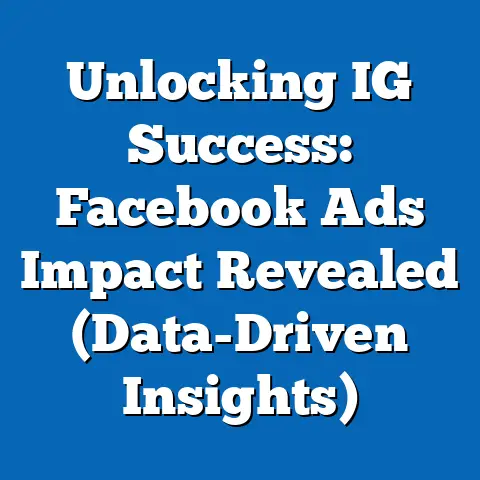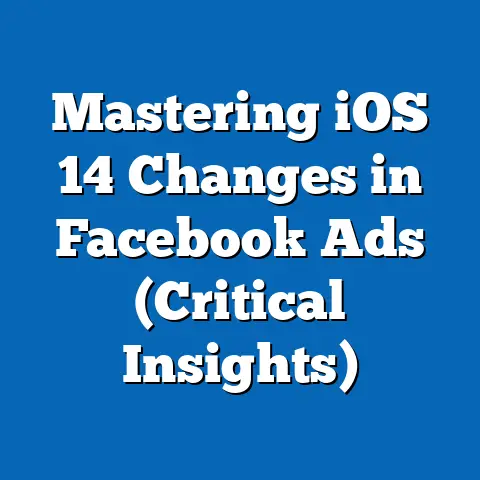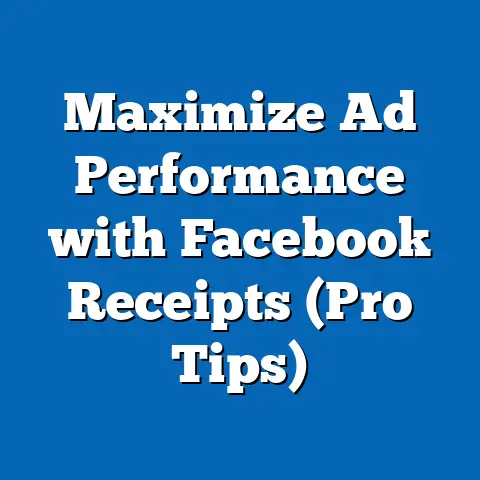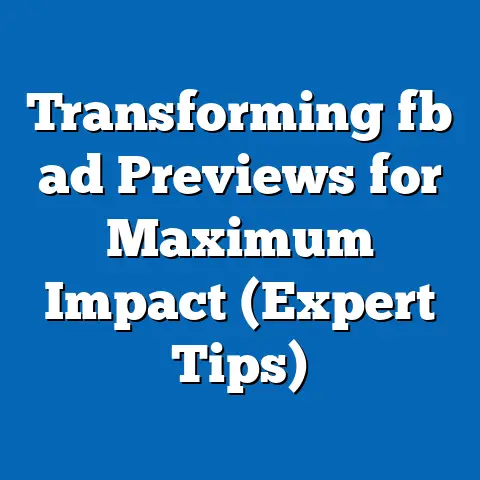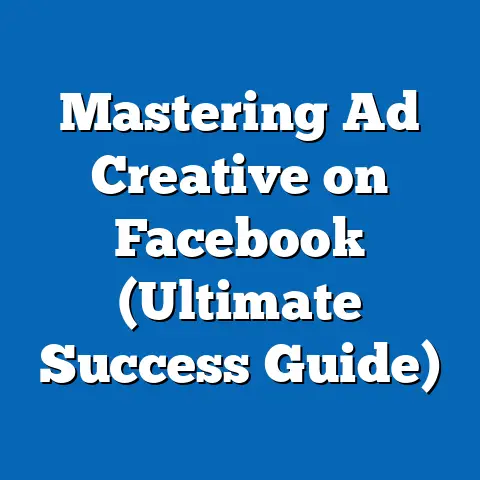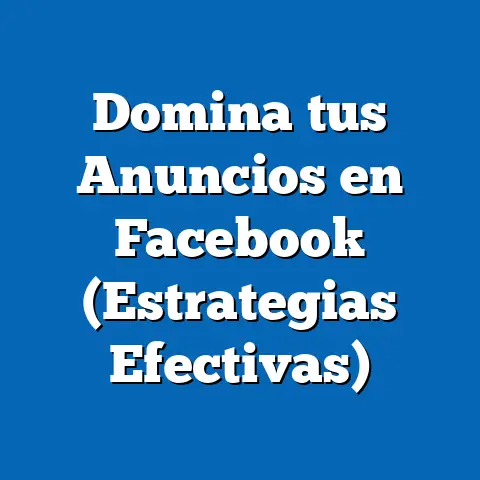Is Facebook Ad Stuck? (Unlock Proven Solutions)
Imagine walking into a smart home. The lights adjust automatically to your presence, the temperature is perfectly set, and your favorite music starts playing as you settle in. Everything works seamlessly, enhancing your comfort and efficiency. Now, think about your Facebook ads. Are they delivering that same seamless experience, effortlessly attracting customers and driving conversions? Or are they stuck in a rut, failing to deliver the results you expect?
In today’s digital landscape, Facebook advertising has become a cornerstone for businesses of all sizes. When Facebook advertising first came about, it was incredibly powerful. But just as technology evolves, so too must our advertising strategies. Many advertisers are finding their once-thriving campaigns plateauing, or even declining. It’s a frustrating reality – you’ve invested time and resources, but your ads are simply not performing.
I’ve been there. I remember working with a client, a local bakery, who saw incredible initial success with their Facebook ads. They were driving foot traffic and online orders like never before. But after a few months, their numbers started to dip. They were spending the same amount, but getting fewer customers. It felt like their ads were shouting into a void.
This experience taught me a valuable lesson: Facebook advertising is not a “set it and forget it” strategy. It requires continuous monitoring, adaptation, and a willingness to explore new solutions.
So, if you’re ready to break free from the stagnation and unlock the full potential of your Facebook ads, let’s get started.
1. Understanding the Current State of Facebook Ads
1.1 The Popularity Surge
Facebook ads burst onto the scene and revolutionized the digital advertising world. It’s hard to believe it’s been around for over 15 years! Remember those early days when you could target incredibly specific demographics with laser-like precision? It felt like magic.
Their initial success was undeniable. Businesses large and small flocked to the platform, drawn by the promise of reaching a massive, engaged audience. Facebook’s user base exploded, and with it, the platform’s advertising capabilities became increasingly sophisticated.
Consider these stats:
- Global Reach: Facebook boasts billions of active users, making it a prime location to tap into a massive audience.
- Targeting Capabilities: The platform offers granular targeting options, allowing advertisers to reach specific demographics, interests, and behaviors.
- Diverse Ad Formats: From image ads to video ads to lead generation forms, Facebook provides a variety of formats to suit different campaign goals.
I recall the early days when a simple image ad with a compelling headline could generate incredible results. The cost per click was low, the reach was high, and conversions were plentiful. It was a golden age for Facebook advertising.
However, as more businesses joined the platform, the landscape began to shift.
1.2 Identifying the Stagnation
While Facebook remains a powerful advertising tool, the landscape has become increasingly competitive. Advertisers are now facing new challenges, including:
- Increased Competition: The sheer volume of ads competing for user attention has skyrocketed, making it harder to stand out.
- Ad Fatigue: Users are bombarded with ads daily, leading to a decline in engagement with repetitive or uninspired creatives.
- Changing User Behavior: User habits and preferences are constantly evolving, requiring advertisers to adapt their strategies accordingly.
I’ve seen firsthand how these challenges can impact campaign performance. One of my clients, an e-commerce store selling handmade jewelry, experienced a significant drop in sales despite maintaining their usual ad spend. They were using the same creatives, targeting the same audience, and running the same campaigns. The problem? Their ads had become stale. Users were simply tuning them out.
This is a common scenario. Many businesses find their initial success fading over time. Their ads, once effective, become lost in the noise. This stagnation can manifest in several ways:
- Decreasing Click-Through Rates (CTR): Fewer users are clicking on your ads, indicating a lack of interest or relevance.
- Rising Cost Per Click (CPC): The cost of acquiring a click is increasing, suggesting greater competition and less efficient targeting.
- Falling Conversion Rates: Fewer users are taking the desired action (e.g., making a purchase, filling out a form) after clicking on your ad.
1.3 Key Metrics to Monitor
To determine if your Facebook ad campaign is “stuck,” it’s crucial to monitor key performance indicators (KPIs). These metrics provide valuable insights into the effectiveness of your ads and help you identify areas for improvement.
Here are some of the most important metrics to track:
- Click-Through Rate (CTR): This measures the percentage of users who click on your ad after seeing it. A low CTR indicates that your ad is not resonating with your target audience.
- Cost Per Click (CPC): This measures the cost of each click on your ad. A high CPC can indicate poor targeting, unappealing creatives, or excessive competition.
- Conversion Rate: This measures the percentage of users who take the desired action (e.g., purchase, sign-up) after clicking on your ad. A low conversion rate suggests issues with your landing page, offer, or overall customer experience.
- Cost Per Acquisition (CPA): This measures the cost of acquiring a customer through your ad. A high CPA indicates inefficiencies in your campaign and a need for optimization.
- Return on Ad Spend (ROAS): This measures the revenue generated for every dollar spent on advertising. A low ROAS indicates that your campaign is not profitable.
- Frequency: This measures the average number of times a user sees your ad. A high frequency can lead to ad fatigue and decreased engagement.
- Relevance Score: Facebook’s metric that estimates how well your ad resonates with your target audience. A low relevance score can result in higher costs and lower reach.
By carefully monitoring these metrics, you can gain a clear understanding of your campaign’s performance and identify areas that need attention.
Takeaway: The initial success of Facebook ads has given way to a more competitive landscape. Monitoring key metrics and identifying signs of stagnation is crucial for maintaining a successful advertising strategy.
2. Common Pitfalls Leading to Stagnation
Understanding the challenges of the modern Facebook advertising landscape is only half the battle. You also need to be aware of the common pitfalls that can lead to stagnation.
2.1 Audience Targeting Issues
One of the biggest mistakes I see advertisers make is neglecting their audience targeting. Facebook’s targeting capabilities are incredibly powerful, but they can also be a double-edged sword. If you’re not careful, you can end up targeting the wrong people, wasting your ad spend, and seeing lackluster results.
Here are some common audience targeting issues:
- Broad Targeting: Casting too wide a net can result in reaching users who are not genuinely interested in your product or service.
- Poorly Defined Interests: Relying on generic interests or demographics can lead to reaching users who are only tangentially related to your target audience.
- Ignoring Lookalike Audiences: Failing to leverage lookalike audiences based on your existing customers can limit your reach to potentially high-converting users.
- Neglecting Retargeting: Not retargeting users who have previously interacted with your website or ads can leave valuable leads on the table.
I remember a time when I was working with a fitness studio that was struggling to attract new members. They were targeting a broad audience of “people interested in fitness” in their local area. The problem was, they were reaching a lot of people who were already members of other gyms or who weren’t seriously interested in joining a studio.
By refining their targeting to focus on specific demographics (e.g., age, income) and interests (e.g., specific types of workouts, healthy eating), they were able to reach a more qualified audience and significantly increase their membership sign-ups.
2.2 Creative Fatigue
Ad fatigue is a real phenomenon. Imagine seeing the same ad over and over again. Eventually, you’ll start to tune it out, no matter how compelling it might have been initially.
Creative fatigue occurs when your target audience becomes overexposed to your ads, leading to a decline in engagement and performance. This can happen for several reasons:
- Repetitive Ads: Showing the same ad creatives to the same audience too frequently.
- Lack of Variation: Not testing different ad formats, visuals, and copy to keep your ads fresh.
- Ignoring Seasonal Trends: Not updating your ads to reflect current events, holidays, or seasonal themes.
I’ve learned that it’s essential to keep your creatives fresh and relevant. A/B testing different headlines, images, and call-to-actions can help you identify what resonates best with your audience and prevent ad fatigue.
2.3 Inadequate Budget Allocation
Budget allocation is another critical factor that can impact your Facebook ad performance. An insufficient budget can limit your reach and visibility, preventing your ads from reaching their full potential.
Here are some common budget allocation issues:
- Low Daily Budgets: Setting daily budgets that are too low to reach a significant portion of your target audience.
- Inconsistent Budgeting: Fluctuating ad spend without a clear strategy or understanding of campaign performance.
- Ignoring Campaign Budget Optimization (CBO): Not leveraging CBO to automatically distribute your budget across your best-performing ad sets.
I’ve seen campaigns that were performing poorly simply because they weren’t given enough budget to succeed. By increasing their daily spend and leveraging CBO, they were able to significantly improve their results.
Takeaway: Common pitfalls like poor audience targeting, creative fatigue, and inadequate budget allocation can lead to stagnation in your Facebook ad campaigns. Identifying and addressing these issues is crucial for revitalizing your ads and achieving your desired results.
3. Proven Solutions to Revitalize Facebook Ads
Now that we’ve identified the common pitfalls, let’s dive into the proven solutions that can revitalize your Facebook ads and unlock their full potential.
3.1 Enhanced Audience Segmentation
The key to successful Facebook advertising is reaching the right people with the right message at the right time. Enhanced audience segmentation involves refining your targeting to focus on the most qualified users.
Here are some actionable strategies for enhanced audience segmentation:
- Leverage Lookalike Audiences: Create lookalike audiences based on your existing customers, website visitors, or email subscribers. Facebook will identify users who share similar characteristics and behaviors, expanding your reach to potentially high-converting users.
- Utilize Retargeting: Retarget users who have previously interacted with your website or ads. This can include people who have visited specific pages, added items to their cart, or watched your videos. Retargeting allows you to re-engage these users with targeted messages and offers.
- Create Custom Audiences: Upload your customer lists, email addresses, or phone numbers to create custom audiences. This allows you to target your existing customers with specific promotions or announcements.
- Layer Targeting Options: Combine different targeting options to create highly specific audiences. For example, you can target people who are interested in fitness, live in your local area, and have a specific income level.
- Test Different Audiences: A/B test different audiences to identify which ones are most responsive to your ads. This can involve testing different demographics, interests, or behaviors.
I’ve seen incredible results from leveraging lookalike audiences. One of my clients, an online clothing store, created a lookalike audience based on their past purchasers. This audience performed significantly better than their previous targeting efforts, resulting in a substantial increase in sales.
Facebook Ads Manager offers a variety of tools and features to help you with audience segmentation. These include:
- Detailed Targeting: Allows you to target users based on demographics, interests, behaviors, and more.
- Custom Audiences: Allows you to upload your own data to create targeted audiences.
- Lookalike Audiences: Allows you to create audiences that are similar to your existing customers.
- Saved Audiences: Allows you to save your targeting criteria for future use.
3.2 Creative Refresh Strategies
Keeping your creatives fresh and relevant is crucial for preventing ad fatigue and maintaining user engagement. Creative refresh strategies involve regularly updating your ads with new visuals, copy, and formats.
Here are some tips for revitalizing your ad creatives:
- A/B Test Different Visuals: Experiment with different images, videos, and graphics to see what resonates best with your audience.
- Write Compelling Copy: Craft headlines, descriptions, and call-to-actions that are attention-grabbing, informative, and persuasive.
- Try Different Ad Formats: Explore different ad formats, such as image ads, video ads, carousel ads, and collection ads, to find what works best for your campaign goals.
- Tell a Story: Use storytelling to connect with your audience on an emotional level. Share testimonials, case studies, or personal anecdotes to build trust and credibility.
- Highlight Benefits, Not Just Features: Focus on the benefits that your product or service provides, rather than just listing its features.
- Use Urgency and Scarcity: Create a sense of urgency and scarcity to encourage users to take action.
- Reflect Seasonal Trends: Update your ads to reflect current events, holidays, or seasonal themes.
I’ve found that storytelling can be incredibly effective in Facebook ads. One of my clients, a local non-profit organization, used a video ad to share the story of a person who had been helped by their services. The ad was incredibly moving and generated a significant increase in donations.
3.3 Budget Optimization Techniques
Optimizing your ad spend is essential for maximizing your return on investment (ROI). Budget optimization techniques involve adjusting your budget based on performance, leveraging automatic bidding strategies, and utilizing campaign budget optimization (CBO).
Here are some methods for optimizing your ad spend:
- Set Up Automatic Bidding Strategies: Use Facebook’s automatic bidding strategies, such as lowest cost or cost cap, to optimize your bids based on your campaign goals.
- Adjust Budgets Dynamically: Monitor your campaign performance and adjust your budgets accordingly. Increase your spend on ad sets that are performing well and decrease your spend on ad sets that are underperforming.
- Utilize Campaign Budget Optimization (CBO): Leverage CBO to automatically distribute your budget across your best-performing ad sets. CBO allows Facebook to optimize your budget in real-time, ensuring that your spend is allocated to the most effective ads.
- Schedule Your Ads: Run your ads during the times of day when your target audience is most active. This can help you improve your reach and engagement.
- Monitor Frequency: Keep an eye on your ad frequency to prevent ad fatigue. If your frequency is too high, consider reducing your budget or pausing your ads.
I’ve seen incredible results from using CBO. One of my clients, an e-commerce store selling pet supplies, implemented CBO and saw a significant increase in their ROAS. Facebook was able to automatically distribute their budget across their best-performing ad sets, resulting in more efficient spending and higher returns.
3.4 Leveraging Data Analytics
Data analytics is the cornerstone of successful Facebook advertising. By effectively using Facebook Insights and other analytics tools, you can monitor your campaign performance, identify areas for improvement, and make data-driven decisions.
Here’s how to effectively use data analytics:
- Track Key Metrics: Regularly monitor your key metrics, such as CTR, CPC, conversion rate, CPA, and ROAS.
- Analyze Audience Demographics: Understand the demographics of your target audience, including their age, gender, location, and interests.
- Identify Top-Performing Ads: Identify which ads are generating the most clicks, conversions, and revenue.
- Test Different Ad Creatives: A/B test different ad creatives to see what resonates best with your audience.
- Optimize Landing Pages: Ensure that your landing pages are optimized for conversions. This includes having clear calls-to-action, compelling copy, and a user-friendly design.
- Use Facebook Pixel: Install the Facebook Pixel on your website to track user behavior and measure the effectiveness of your ads.
I’ve seen businesses turn around underperforming ads through careful analysis and adjustment. By monitoring their key metrics, they were able to identify that their ads were not resonating with their target audience. They then tested different ad creatives and landing pages, and eventually found a winning combination that significantly improved their results.
Takeaway: Revitalizing your Facebook ads requires a comprehensive approach that includes enhanced audience segmentation, creative refresh strategies, budget optimization techniques, and leveraging data analytics. By implementing these proven solutions, you can break free from stagnation and unlock the full potential of your Facebook advertising.
4. Case Studies of Successful Campaigns
To illustrate the power of these proven solutions, let’s examine some real-world examples of businesses that successfully overcame stagnation in their Facebook ad campaigns.
4.1 Real-World Examples
-
Case Study 1: Local Restaurant
- Challenge: A local restaurant was struggling to attract new customers through their Facebook ads. Their ads were targeting a broad audience and using generic images of their food.
- Solution: They refined their targeting to focus on people who were interested in specific types of cuisine (e.g., Italian, Mexican) and lived within a 5-mile radius of their restaurant. They also updated their ad creatives with professional photos of their most popular dishes and included a compelling offer (e.g., 20% off your first order).
- Results: They saw a significant increase in their click-through rates, conversion rates, and overall sales.
-
Case Study 2: E-commerce Store
-
Challenge: An e-commerce store selling handmade jewelry was experiencing ad fatigue. Their ads were using the same creatives for months, and their engagement was declining.
- Solution: They implemented a creative refresh strategy, A/B testing different visuals, copy, and formats. They also started using video ads to showcase their products in a more engaging way.
- Results: They saw a significant increase in their click-through rates, conversion rates, and overall sales.
-
Case Study 3: Online Coaching Business
-
Challenge: An online coaching business was not getting enough leads through their Facebook ads. Their budget was spread too thinly across multiple ad sets, and they were not leveraging CBO.
- Solution: They consolidated their budget into a single campaign and implemented CBO. They also refined their targeting to focus on their ideal client profile.
- Results: They saw a significant increase in their lead generation and a decrease in their cost per lead.
Case Study 1: Local Restaurant
- Challenge: A local restaurant was struggling to attract new customers through their Facebook ads. Their ads were targeting a broad audience and using generic images of their food.
- Solution: They refined their targeting to focus on people who were interested in specific types of cuisine (e.g., Italian, Mexican) and lived within a 5-mile radius of their restaurant. They also updated their ad creatives with professional photos of their most popular dishes and included a compelling offer (e.g., 20% off your first order).
- Results: They saw a significant increase in their click-through rates, conversion rates, and overall sales.
-
Case Study 2: E-commerce Store
-
Challenge: An e-commerce store selling handmade jewelry was experiencing ad fatigue. Their ads were using the same creatives for months, and their engagement was declining.
- Solution: They implemented a creative refresh strategy, A/B testing different visuals, copy, and formats. They also started using video ads to showcase their products in a more engaging way.
- Results: They saw a significant increase in their click-through rates, conversion rates, and overall sales.
-
Case Study 3: Online Coaching Business
-
Challenge: An online coaching business was not getting enough leads through their Facebook ads. Their budget was spread too thinly across multiple ad sets, and they were not leveraging CBO.
- Solution: They consolidated their budget into a single campaign and implemented CBO. They also refined their targeting to focus on their ideal client profile.
- Results: They saw a significant increase in their lead generation and a decrease in their cost per lead.
Case Study 2: E-commerce Store
Challenge: An e-commerce store selling handmade jewelry was experiencing ad fatigue. Their ads were using the same creatives for months, and their engagement was declining.
Case Study 3: Online Coaching Business
Challenge: An online coaching business was not getting enough leads through their Facebook ads. Their budget was spread too thinly across multiple ad sets, and they were not leveraging CBO.
4.2 Lessons Learned
These case studies highlight the importance of adaptability and continuous learning in Facebook advertising. Here are some key takeaways that you can apply to your own campaigns:
- Refine Your Targeting: Don’t be afraid to experiment with different targeting options to find what works best for your business.
- Keep Your Creatives Fresh: Regularly update your ad creatives to prevent ad fatigue and maintain user engagement.
- Optimize Your Budget: Use automatic bidding strategies and CBO to maximize your ROI.
- Leverage Data Analytics: Monitor your key metrics and make data-driven decisions to improve your campaign performance.
- Stay Up-to-Date: Facebook’s advertising platform is constantly evolving, so it’s important to stay up-to-date on the latest features and best practices.
Takeaway: By learning from the successes and failures of others, you can gain valuable insights and improve your own Facebook ad campaigns. Adaptability and continuous learning are key to long-term success in the ever-changing world of digital advertising.
Conclusion
Stagnation in Facebook ads is a common challenge, but it’s not an insurmountable one. By understanding the reasons why ads stagnate, avoiding common pitfalls, and implementing proven solutions, you can revitalize your campaigns and achieve your desired results.
Remember that your advertising strategies should be viewed as dynamic processes that require ongoing refinement and innovation. Just like the evolution of smart home technology, the landscape of digital advertising is ever-changing. Staying ahead involves a commitment to exploration, adaptation, and continuous learning.
Don’t be afraid to experiment with different targeting options, ad creatives, and budget optimization techniques. Leverage data analytics to monitor your campaign performance and make data-driven decisions. And most importantly, stay up-to-date on the latest features and best practices.
By embracing these principles, you can break free from the stagnation and unlock the full potential of your Facebook advertising. So go out there, experiment, learn, and grow. Your next successful campaign is just around the corner.
The world of Facebook ads is constantly evolving, and the solutions that work today may not work tomorrow. But by staying informed, adaptable, and committed to continuous improvement, you can ensure that your Facebook ads continue to deliver the results you expect. Just like a well-designed smart home, your Facebook ads can work seamlessly to attract customers, drive conversions, and grow your business.

